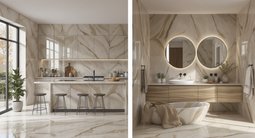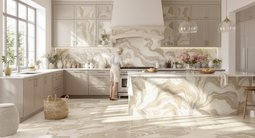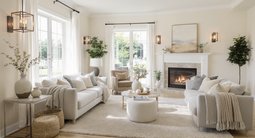TL;DR
In 2025, the living room rug trend is less about a blanket rule and more about intention. Area rugs anchor seating, soften acoustics, and add texture; skipping a rug keeps a minimalist living room crisp and easy to clean. Choose a pet-friendly rug or define the zone with lighting and layout — both paths work when the design is deliberate. Long-tail keyword: “should I use a rug in a minimalist living room.”
Rug vs. Rugless: The Feel-Good Design Debate of 2025

A clean, rug-free living room showcasing minimalist calm and streamlined living for modern spaces.
Debating a living room rug? In 2025, area rugs balance minimalist design with warmth, acoustics, and pet-friendly performance materials.
Here’s the thing: today’s living rooms are multitaskers. We want clean lines and easy maintenance, but we also want warmth, sound absorption, and a clear sense of where life actually happens. The living room rug — or the conscious decision to forgo one — has become a defining move.
Designers say the best spaces start with intent. A living room rug can anchor furniture, frame circulation, and add tactility to modern flooring. But in homes with underfloor heating or energetic pets, a rugless layout can feel cleaner and more streamlined. The 2025 trend isn’t pro or anti rug; it’s about choosing the right move for your minimalist living room, your lifestyle, and your floor.
Trend Overview
This year’s interiors are slowing down, trading high-gloss perfection for lived-in calm. Across apartments and open floor plans, three themes unite the conversation: tactility, practicality, and clarity. Short-tail keywords like “area rug,” “living room rug,” and “minimalist living room” show up in nearly every brief.
Textured natural fiber rugs, performance materials for pet-friendly spaces, and thoughtful rugless layouts all serve the same goal: rooms that feel intentional. Designers often advise that an area rug should make a seating zone feel complete, while a no-rug plan should still read as deliberate through lighting, art, and furniture placement.
Anecdote
A modern apartment with radiant heat and a herding dog went rugless — then added floor-to-ceiling drapery and a single arc lamp. The room felt finished without sacrificing easy cleaning.
Design Trends: When to Add a Rug — and When to Go Rugless
An area rug anchors a seating zone, softens acoustics, and visually unites furniture; at minimum, place the front legs of sofas and chairs on the rug. Experts often recommend leaving 8 to 12 inches of bare floor around a rug in smaller rooms, up to 18 inches in larger spaces.
The look is modern, not fussy: think a 9×12 for generous living rooms or an 8×10 for compact settings, with the coffee table centered. A living room rug also absorbs sound in hard-surface spaces, making conversation feel calmer. If you love minimalism but want warmth, a solid or heathered neutral in wool or a wool blend adds texture without visual noise. Designers often note that a well-sized rug is the difference between a room that feels “finished” and one that feels like floating furniture.
How to Bring It Home
- Size up: choose the largest rug your room can handle so at least the front legs of seating land on it.
- Keep clearance: 8–12 inches of visible floor along the perimeter (up to 18 inches in large rooms).
- Start neutral: layer color through pillows, throws, or art if you’re rug-shy.
Pet-Friendly Rug Performance: Washable, Low-Pile, High-Style
For homes with pets, choose a pet-friendly rug with low pile, stain-resistant fibers, and tight construction; avoid viscose and high shag that trap mess. A useful rule of thumb: keep pile height at or below 0.5 inch for easier cleaning and safer vacuuming.
Materials like wool, solution-dyed polypropylene, and PET (often made from recycled bottles) resist stains and wear. Washable rug systems are lifesavers for households with cats and dogs, and busy patterns in mid-tone colors hide fur and daily debris. If you have underfloor heating, use a breathable pad and low-pile rug rated for radiant floors to avoid trapping heat. Designers often advise choosing medium, heathered tones so pet fur blends in and the space still looks polished day to day.
How to Bring It Home
- Material matters: wool, polypropylene, or PET; skip viscose and deep shag for pets.
- Pattern smart: speckled, heathered, or small-scale motifs camouflage life’s moments.
- Clean routine: blot within minutes, use enzyme cleaners, and schedule periodic professional cleaning.
Rugless Minimalism: A Minimalist Living Room Without a Rug
Going rugless emphasizes clean lines, easy cleaning, and the beauty of flooring, especially with underfloor heating and a busy pet household. To keep the seating grounded, align the coffee table 14 to 18 inches from the sofa and use lighting, art, and drapery to define the zone.
No rug doesn’t mean no warmth. Floor-to-ceiling curtains, a sculptural sectional, and a textured throw can deliver softness without adding a textile underfoot. Add felt pads under furniture, a floor lamp to “dot” the corner, and a plant to bring life. If acoustics are an issue, consider fabric wall art or a soft ottoman. Designers note that a rugless plan succeeds when spacing, symmetry, and vertical soft elements do the work of anchoring.
How to Bring It Home
- Layer vertically: drapery, wall art, and tall plants add softness without floor coverage.
- Mind the gaps: keep 14–18 inches between sofa and coffee table for comfort and flow.
- Light the zone: a statement floor lamp can visually “pin” the seating area in place.
Trend Crossovers, Expert Anecdotes & Visualization
Across these approaches, the throughline is tactile calm. Whether you choose a natural fiber area rug or embrace rugless minimalism, the palette leans warm neutrals, the shapes are soft, and contrast is intentional. One powerful move this year is pairing sleek modern furniture with a traditional rug — a vintage Persian under a mid-century sofa — letting contrast showcase both. Designers often advise that one standout element can define a room more elegantly than many small accents.
Expert Insights & Mini-Anecdotes
“If you’re unsure, size up,” many pros say. The larger rug (or the bolder choice to skip one) usually makes the room feel more intentional.
In one modern living room with oak floors and radiant heat, the owners went rugless for easy cleaning with pets; adding full-height drapery and a single sculptural floor lamp brought all the warmth they were missing.
Another homeowner layered a moss-green bouclé throw and an antique red rug beneath a minimalist sofa. Suddenly, the room felt alive — proof that color and history can coexist with clean lines.
Tools, Resources & Visualization
Test-drive both options with ReimagineHome: visualize a 9×12 wool-blend under your sectional, or compare a rugless layout with softer drapery and a large plant. Picture a living room bathed in warm taupe, brushed brass accents, and a textured runner guiding the eye — quiet luxury without pretense.
Suggested image alt text: “Minimalist living room with oak floors; large neutral area rug anchoring a sectional in a warm, modern palette.” Caption: “A generously sized rug (8×10 or 9×12) unites seating and softens acoustics.”
What People Often Get Wrong About 2025 Design Trends
- Mistaking minimalism for emptiness — even a rugless plan needs softness from drapery, art, or lighting.
- Buying rugs too small — aim for front legs on the rug and size up to 8×10 or 9×12 for standard living rooms.
- Choosing delicate fibers for pets — avoid viscose and deep shag; pick wool or performance blends.
- Ignoring radiant heat — use low-pile rugs and breathable pads rated for underfloor heating.
- Overloading patterns — if the rug has movement, keep nearby textiles calmer for balance.
Visualization Scenario
Use ReimagineHome to toggle between a 9×12 wool-blend rug under your sofa and a rugless layout with long drapery and a bold floor lamp; compare warmth, scale, and flow in seconds.
FAQ
Should I use a rug in a minimalist living room?
Yes, if you want warmth, sound absorption, and a defined seating area; a rugless minimalist living room can work too if you use lighting, drapery, and furniture placement to anchor the zone.
What’s the best rug size for a sectional sofa?
Designers often recommend 8×10 or 9×12, ensuring at least the front legs of the sectional sit on the rug and there’s 8–12 inches of floor visible around the perimeter.
Are rugs good for homes with pets?
Yes, choose pet-friendly rugs in wool, polypropylene, or PET with low pile and tight weave; washable rug systems and heathered patterns help hide fur and simplify cleaning.
Can you put a rug over underfloor heating?
Yes, use low-pile rugs and breathable pads rated for radiant floors to prevent heat buildup, and confirm compatibility with the flooring and heating manufacturer.
A Softer, Smarter Minimalism
In 2025, living room design isn’t about rigid rules; it’s about clarity of intent. An area rug can anchor, warm, and quiet a space in a single move. A rugless layout can celebrate beautiful flooring, speed up daily cleaning, and keep a minimalist living room crisp. Both paths succeed when the space still tells one story.
Try the option that best suits your lifestyle, then fine-tune with size, material, and a few smart layers. And if you’re wavering, visualize it first with ReimagineHome — the easiest way to see whether a living room rug or a confident rugless plan feels more like home.
.svg)

.svg)
.jpg)













.png)